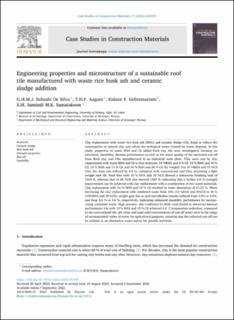| dc.contributor.author | Subashi De Silva, G. H. M. J. | |
| dc.contributor.author | Aagani, T.H.F | |
| dc.contributor.author | Gebremariam, Kidane Fanta | |
| dc.contributor.author | Samarakoon, Mudiyansele Samindi Manjula K | |
| dc.date.accessioned | 2023-03-22T10:01:53Z | |
| dc.date.available | 2023-03-22T10:01:53Z | |
| dc.date.created | 2022-09-13T10:03:49Z | |
| dc.date.issued | 2022 | |
| dc.identifier.citation | De Silva, G. S., Aagani, T. H. F., Gebremariam, K. F., & Samarakoon, S. S. M. (2022). Engineering properties and microstructure of a sustainable roof tile manufactured with waste rice husk ash and ceramic sludge addition. Case Studies in Construction Materials, 17, e01470. | en_US |
| dc.identifier.issn | 2214-5095 | |
| dc.identifier.uri | https://hdl.handle.net/11250/3059771 | |
| dc.description.abstract | Clay replacement with waste rice husk ash (RHA) and ceramic sludge (CS), helps to reduce the consumption of natural clay and solves the ecological issues created by waste disposal. In this study, properties of waste RHA and CS added fired clay tile were investigated, focusing on structural, durability, thermal performance as well as the water quality of the harvested run-off from fired clay roof tiles manufactured in an industrial scale plant. Tiles were cast by clay replacement with waste RHA and CS in four mixtures: 10 %RHA and 0 % CS, 10 % RHA and 10 % CS, 10 % RHA and 15 % CS, and 10 % RHA and 20 % CS (by weight). For 10 %RHA and 10 %CS tiles, dry mass was reduced by 4.9 %, compared with conventional roof tiles, promising a light weight roof tile. Roof tiles with 10 % RHA and 10 %CS showed a transverse breaking load of 1519 N, whereas that of 20 %CS tiles showed 1427 N, indicating that a further 6.5 % strength improvement can be achieved with clay replacement with a combination of two waste materials. Clay replacement with 10 % RHA and 10 % CS resulted in water absorption of 15.25 %. When increasing the clay replacement with combined waste from 10% (10 %RHA and 0%CS) to 30 % (10%RHA and 20 %CS), weight gain due to acid and alkaline attacks reduced from 3.5% to 3.0%, and from 2.2 % to 1.6 %, respectively, indicating enhanced durability performance by incorporating combined waste. High porosity, also confirmed by SEM, contributed to enhanced thermal performance: tile with 10 % RHA and 10 % CS achieved 4.4 °C temperature reduction, compared to the conventional tile. pH value and total solid concentration of run-off water were in the range of recommended values of water for agricultural purposes, ensuring that the collected run-off can be utilized as an alternative water source for potable activities. | en_US |
| dc.language.iso | eng | en_US |
| dc.publisher | Elsevier | en_US |
| dc.rights | Navngivelse 4.0 Internasjonal | * |
| dc.rights.uri | http://creativecommons.org/licenses/by/4.0/deed.no | * |
| dc.title | Engineering properties and microstructure of a sustainable roof tile manufactured with waste rice husk ash and ceramic sludge addition | en_US |
| dc.type | Peer reviewed | en_US |
| dc.type | Journal article | en_US |
| dc.description.version | publishedVersion | en_US |
| dc.rights.holder | The authors | en_US |
| dc.subject.nsi | VDP::Teknologi: 500 | en_US |
| dc.source.volume | 17 | en_US |
| dc.source.journal | Case Studies in Construction Materials | en_US |
| dc.identifier.doi | 10.1016/j.cscm.2022.e01470 | |
| dc.identifier.cristin | 2051071 | |
| cristin.ispublished | true | |
| cristin.fulltext | original | |
| cristin.qualitycode | 1 | |

